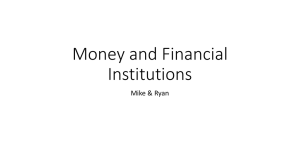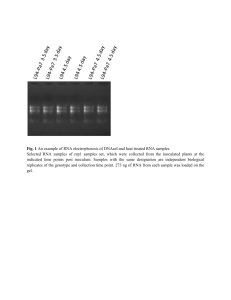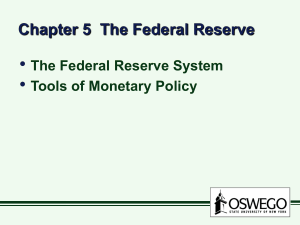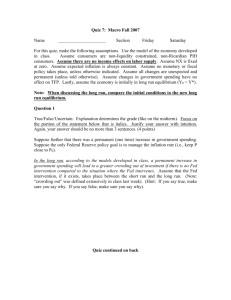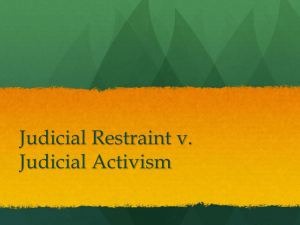Specific jurisdiction - Indiana Journal of Global Legal Studies
advertisement
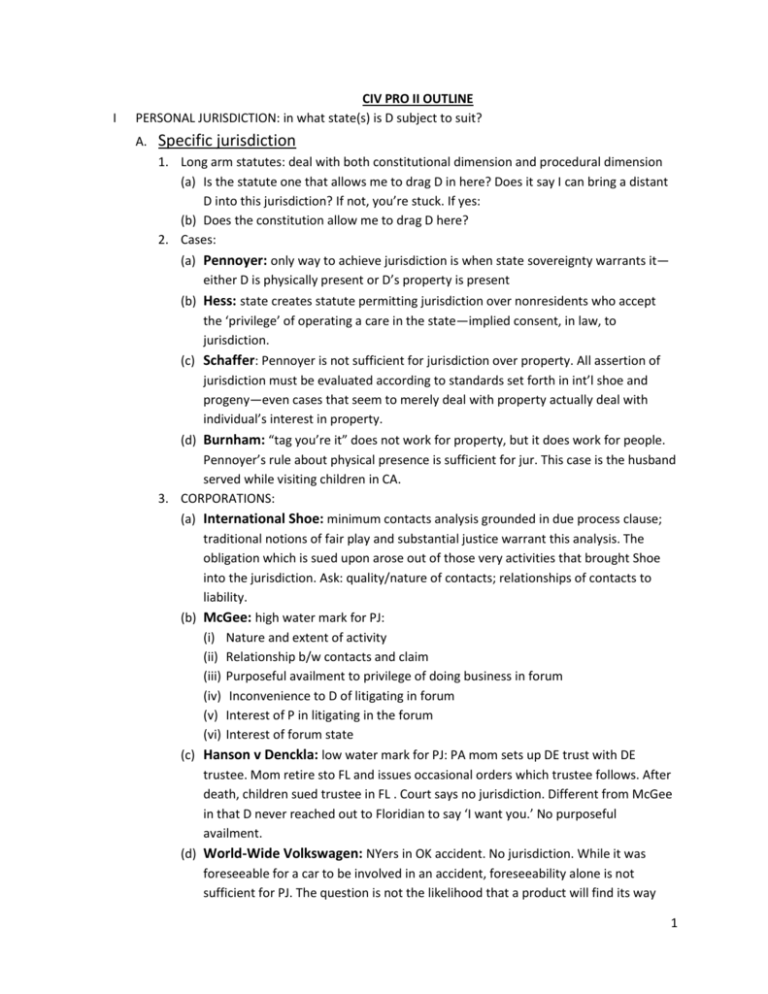
I CIV PRO II OUTLINE PERSONAL JURISDICTION: in what state(s) is D subject to suit? A. Specific jurisdiction 1. Long arm statutes: deal with both constitutional dimension and procedural dimension (a) Is the statute one that allows me to drag D in here? Does it say I can bring a distant D into this jurisdiction? If not, you’re stuck. If yes: (b) Does the constitution allow me to drag D here? 2. Cases: (a) Pennoyer: only way to achieve jurisdiction is when state sovereignty warrants it— either D is physically present or D’s property is present (b) Hess: state creates statute permitting jurisdiction over nonresidents who accept the ‘privilege’ of operating a care in the state—implied consent, in law, to jurisdiction. (c) Schaffer: Pennoyer is not sufficient for jurisdiction over property. All assertion of jurisdiction must be evaluated according to standards set forth in int’l shoe and progeny—even cases that seem to merely deal with property actually deal with individual’s interest in property. (d) Burnham: “tag you’re it” does not work for property, but it does work for people. Pennoyer’s rule about physical presence is sufficient for jur. This case is the husband served while visiting children in CA. 3. CORPORATIONS: (a) International Shoe: minimum contacts analysis grounded in due process clause; traditional notions of fair play and substantial justice warrant this analysis. The obligation which is sued upon arose out of those very activities that brought Shoe into the jurisdiction. Ask: quality/nature of contacts; relationships of contacts to liability. (b) McGee: high water mark for PJ: (i) Nature and extent of activity (ii) Relationship b/w contacts and claim (iii) Purposeful availment to privilege of doing business in forum (iv) Inconvenience to D of litigating in forum (v) Interest of P in litigating in the forum (vi) Interest of forum state (c) Hanson v Denckla: low water mark for PJ: PA mom sets up DE trust with DE trustee. Mom retire sto FL and issues occasional orders which trustee follows. After death, children sued trustee in FL . Court says no jurisdiction. Different from McGee in that D never reached out to Floridian to say ‘I want you.’ No purposeful availment. (d) World-Wide Volkswagen: NYers in OK accident. No jurisdiction. While it was foreseeable for a car to be involved in an accident, foreseeability alone is not sufficient for PJ. The question is not the likelihood that a product will find its way 1 into the state, but that D’s conduct and connection with the state are such that he should reasonably anticipate being haled into court there—purposeful availment provides clear notice of jur; requires some sort of volitional action, reaching out and taking advantage of things going on in that state. (e) Calder: effects test, 3 elements: (i) D committed an intentional tort (ii) P felt the burn of the harm caused by that tort in the forum (iii) D expressly aimed his conduct at the forum such that the forum is the focal point of the torious activity • Keeton v Hustler: Calder effect’s test: your actions are targeted if it is reasonable to expect the bulk of the harm from your act to be felt in a certain forum. • Feilding v Hubert: P originally TX now in Germany, sues for libel in TX where 60 issues of magazine are sold. No jur because the article concerned the German activities of individuals in Germany; 60 issues is not enough to say that traditional jur holds and the effects test is not applicable where P is not in forum. • Gordy v Daily News: CA P files libel suit in CA for article where 13 copies are sold in CA. Jur appropriate under effects test where ‘the prime targeting arises from the face that Gordy is an individual who lives in CA’ • Madara v Hall: FL P sues NY rock star in FL over defamatory comments made while interviewing with CA magazing. No jur because rock star was not mag’s publisher and did not control its circulation/distribution. His awareness that a small number might find their way to FL is not enough • Geyh thinks this should really be an effects test that turns on whether star knows P lives in FL—circulation matters only if rock star didn’t know where targeted person lives. 4. Burger King: (a) Minimum contacts analysis: (i) Nature/extend of contact (ii) Relationship between contact/claim (iii) Purposeful availment (iv) Foreseeability of being haled into court (b) Fair play factors: can tip fence-sitting cases (i) Burden on D (ii) Interest of P (iii) Interest of forum state 5. Asahi: purposeful availment & awareness: sold to global manufacturer, this is an established chain of distribution, not a random stream of commerce like that seen in Worldwide. Is awareness that products are being incorporated into tires sold in CA? 2 (a) 4 justices: no, substantial connection between D and the forum state necessary for a finding of minimum contacts. Awareness that product will be swept into forum state does not constitute an act of purposefully directed toward the state. (b) 4 justices say yes: awareness of the distribution system’s operation and that it would benefit from forum state’s incorporation of its components is enough. (c) Justice Stevens: group hug, this is a toughy. B. GENERAL JURISDICTION: follow BK multifactor analysis—lots of contacts but lawstui arises out of events that occurred somewhere else; deals with cases in which is is fair to hold someone answerable in jurisdictions that are like their homes 1. Goodyear: some tires end up in NC for limited reasons but not the type of tire that caused the suit. No jurisdiction—foreign subsidiaries lacked significant connect to NC. Analogizes sites of general jur to D’s home. C. INTERNET: what does it take to purposefully avail when so little effort is involved? 1. Pavlovich: created website that only provided info on de-encryption software; did not solicit or transact any business. Sued in CA for misappropriating their trade secrets. D’s site is purely passive: does little more than making info available to those who are interested— this is not grounds for PJ. (a) Zippo sliding scale analysis: 3 categories for figuring out what kind of site (i) D clearly does business over internet (ii) Interactive websites, whether a user can exchange info (iii) D has simply posted info on an internet website (b) Effects test comes into play if you consider that Hollywood is obviously the center of gravity for the film industry. This is not enough, though: foreseeability not enough, we want more evidence of specific targeting. 3 II SERVICE OF PROCESS: is D subject to service in the chosen form? A. Mullane: Newspaper publication in limited forum that did not identify beneficiaries, was brief, and cryptic, did not satisfy service to inform trustees that accounting was occurring. Here, chance alone would bring this type of advertisement to the attention of even locals. Bank should alert beneficiaries individuals when addresses known, when not known notice by publication OK 1. Test: notice must be reasonably calculated, under all the circumstances, to apprise interested parties of the pendency of the action and afford them an opportunity to present their objections. B. FRCP 4: if you satisfy the rule, you must still satisfy the constitution—some of the options in the rule can open the door to constitutional questions 1. 4c: who can serve a complaint? (a) Any person who is not a party AND is over 18 (b) P may ask court to have marshal serve 2. 4d: waiver process (a) Alternative to service under e, f, and h (b) Plaintiff: (i) Mails complaint to D, officer, or agent, and (ii) Gives D at least 30 days after request sent to return waiver (iii) Furnishes form warning for failure to waive (c) Defendant: (i) Who doesn’t comply is subject to service costs (ii) Who complies has 60 days to answer from date waiver request sent 3. If D does not waive, then follow one of these: (a) 4e: service on individuals (i) Follow service rules of state where court is or where service is accomplished; or (ii) Deliver complaint to D or someone of suitable age/discretion at his house (note: this federal method will always meet con standards whereas state rules may not) (b) 4h: service on corporations (i) Follow service rules of state where court is or where service is accomplished; or (ii) Deliver complaint to officer, general agent, or authorized agent (not just a general employee). (c) 4i: service on US gov’t (i) Serve US atty/designee; and (ii) Certified mail to AG; and (iii) Certified mail to officer/agency (if any) 4. 4(k): applies PJ to federal courts (a) In general: serving a summons or filing a waiver of service establishes PJ over D: (i) Who is subject to the jurisdiction of a court of general jurisdiction in the state where the district court is located [if you were a judge in a state court across the street]; (ii) Who is a party joined under R14/19 and is served within a judicial district of the US and not more than 100 mi from where summons was issued; or 4 (iii) When authorized by a federal statute (b) Fed claim outside state court jurisdiction: for a claim that arises under fed law, service a summons or filing a waiver of service establishes personal jurisdiction over D if: (i) D is not subject to jur in any state’s courts of general jur; and (ii) Exercising jur is consistent with the US constitution/laws 5 III VENUE & FORUM NON-CONVENIENS: in what district(s) may D be sued? A. 1391: where venue is proper 1. (b) Venue in General.— A civil action may be brought in— (a) (1) a judicial district in which any defendant resides, if all defendants are residents of the State in which the district is located; (b) (2) a judicial district in which a substantial part of the events or omissions giving rise to the claim occurred, or a substantial part of property that is the subject of the action is situated; or (c) (3) if there is no district in which an action may otherwise be brought as provided in this section, any judicial district in which any defendant is subject to the court’s personal jurisdiction with respect to such action. B. 1404 change of venue: transfer from one proper venue to another—if the interest of the parties, justice, and so on must net to be more efficient for a forum change (Earth Dweller) 1. (a) for the convenience of parties and witnesses, in the interest of justice, a district court may transfer any civil action to any other district or division where it might have been brought or to any district or division to which all parties have consented C. 1406: transfer from an improver venue to a proper one: 1. Can also use FRCP 12b3 to dismiss a case for improper venue (used as a defense) 2. (a) the district court of a district in which is filed a case laying venue in the wrong division or district shall dismiss, or if it be in the interest of justice, transfer such case to any district in which it could have been brought. D. Forum Non-Conveniens: if violative of forum non, the case is not transferred somewhere else, it is dismissed. This is useful to dismiss cases where we are in the best venue in the US to litigate the issue but it is still so inconvenient as to make a fair hearing impossible. Most likely scenario: foreign jur makes more sense. 1. Piper Aircraft v Reyno: weigh the following factors in order to determine whether forum non is appropriate (zero in on the most persuasive factors; don’t spend time on all eight) (a) Private interest factors: (i) Access to proof/premises (ii) Availability of witnesses (iii) Other factors that make trial easy, expeditious, inexpensive (b) Public interest factors: (i) Court congestion (ii) Local interest in suit (iii) Competence over applicable law (iv) Avoiding conflict of law problems (v) Burdening local jurors in unrelated forum 6 IV SMJ, REMOVAL, REMAND: in what court system (state/fed) may suit be brought? A. SMJ 1. Diversity of citizenship (a) 1332: diversity of citizenship; amount in controversy (i) (a) Limited to cases involving complete diversity and are over $75K • One party may combine unrelated claims against D to reach $75K • coP’s, none of whom have $75K, may not combine to meet threshold • if one co P has $75K, others with less may be joined. (ii) (c)(1) corporation shall be deemed a citizen of any state by which it has incorporated and the state where it has its principal place of business • Nerve center approach: principle place of business is best read as referring to the place where a corp’s officers direct, control, and coordinate the corp’s activities. It should normally be the place where the corp maintains its HQ. (b) Mas v Perry: wife is French but lives in LA; D argues no complete diversity. Decidedly a citizen from MI b/c no intention to live anywhere permanently and she was from MI; you stay a citizen of where you’re from until you become a citizen of somewhere else (i) Difference b/w domicile and residence: test for domicile/citizenship is residence with intention to remain indefinitely—residence alone not enough, intention to live not enough. (ii) Citizenship decided the moment complaint is filed (c) 1359: if any party acts in order to create diversity in a collusive manner, it isn’t recognized. Does not say that you cannot collude to destroy diversity. 2. FED QUESTION (a) Louisville RR v Mottley: settlement from RR that gave Mottle free tickets for life. (i) Not a fed question: original cause of action must be what arises under the con/fed law, not the answer or defense—can’t bring a case on the assumption that D is going to raise something. (b) 1331: fed question must be embedded in the complaint (i) Well-pled complaint requirement: cannot include fed question in complain by saying “D will claim a constitutional defense, but…” (ii) Grables & Sons v Darue: IRS seized real estate sold to Darue, Grable brings quiet title suit b/c title invalid due to IRS’s failure to notify Grable according to fed req. Here, fed issue is whether notification was proper, even though it arises in a suit for quiet title (state law). “the question is, does a state-law claim necessarily raise a stated federal issue, actually disputed and substantial, which a federal forum may entertain without disturbing any congressionally approved balance of federal and state judicial responsibilities.” Need: • Contested federal issue 7 • Substantial issue, indicating a serious federal interest in claiming the advantages thought to be inherent in a federal forum • Fed jur is consistent with congressional judgment about the sound division of labor b/w state and fed courts (fed/state division of labor) (c) 1257: more expansive—SC has jur over any fed question that pops up anywhere (i) Final judgments or decrees rendered by the highest court of a stae in which a decision could be had, may be reviewed by SCOTUS by writ of certiorari where the validity of a treaty or statute of the US is drawn in question or where the validity of a statute of any State is questioned on the ground of its being repugnant to the constitution, treiaties, or laws of the US, or where any title, right, privilege, or immunity is specially set up or claimed under the constitution or the treaties or statutes of, or any commission held or authority exercised under, the US. 3. SUPPLEMENTAL JUR: the authority of fed courts to hear additional claims substantially related to the original claim even though the court would lack SMJ to hear the additional claims independently. (a) 1367: (i) (a) fed court shall have supp jrisidction over all other claims that are so related to claims in the action within such original jurisdiction that they form part of the same case or controversy. Includes claims that involve joinder/intervention of parties. (ii) (b) for cases founded solely under diversity, court shall not have supp jur over claims by P against persons made parties under 14,19.20.24 if jurisdiction over those claims would break diversity. (iii) (c) may decline to exercise supp jur for variety of reasons (b) Ancillary jur: added by defendants—applies when the parties are in fed court because of diversity and one party wants to bring a claim against another party (possibly a 3rd party) which would otherwise defeat diversity. Ancillary claim: rule 13a counterclaim; ancillary party: rule 14 impleader. (i) Owen Equipment & Erection v Kroger: Kroger was a plaintiff who had chosen federal court and the claim against Owen was "entirely separate" from her original claim against OPPD "since [Owen's] liability to her depended not at all upon whether or not OPPD was also liable." Thus, the court generally upheld the complete diversity requirement of 1332 but allowed certain limited exceptions for ancillary jurisdiction. Kroger, however, did not meet those exceptions. two limits on ancillary jur beyond the “common nucleas of operative fact” of Gibbs: • Non-fed claim must be ancillary and dependent on original claim, rather than new and independent; and • Courts can be more lenient to D than to P because P chose where claims brought (c) Pendent jur: added by Ps/claimants—authority of fed court to hear a closely related state law claim against a party already facing a fed claim, described by SC as “jur over 8 nonfed claims b/w parties litigating other matters properly before the court.” Pendent claim: rule 18 joinder of claims; pendent party: rule 20 permissive joinder of parties (i) United Mine Workers of Am v Gibbs: Court requires: (1) must be a fed claim, and (2) non-fed claim must arise ‘from a common nucleus of operative fact’ such that a P would ordinarily be expected to try them in one judicial proceeding B. • Note: even though fed claim was thrown out on summary judgment, jur over state claim was OK because at time of filing, it was constitutional to have jur over it and it made efficiency sense b/c most of the trial had already occurred by time directed verdict against fed claim was made. • Summary of method of analysis: • Applies only where one but not all claims are supported by fed question jur • Examine the claim w/o independent jur support to determine if it arises out of the same nucleus of operative fact as the claim with the jur support • If not, no con authority to hear claim • If yes, con authority to hear the supp claim • Note: this is by court discretion, not P’s right—efficiency supported doctrine • Considerations to determine discretionary decision: needless decisions of state law should be avoided as a matter of comity; fed claims re dismissed before trial; state issues substantially predominate; state claim closely tied to federal policy; jury confusion, etc. REMOVAL & REMAND (a) 1441a: any civil action brought in a state court of which the fed courts have original jur may be removed by the D(s). substantial requirements: (i) Requires consensus if more than one D (ii) Limited to removing to fed court wherever state court located—move up first, then to convenient forum second (b) 1441b: any civil action of which the district courts have original jurisdiction founded on SMJ shall be removable without regard to citizenship. Any other such action shall be removable only if none of the parties in interest properly joined and served as Ds is a citizen of the state in which such action is brought. (c) 1441c: whenever a separate and independent claim within subject mater jur is joined with one or more otherwise non-removable claims, the entire case may be removed and the district court may determine all issues therein, or, in its discretion, may remand all matters in which state law predominates. (i) Ex: IN P filed fed claim against IN D in state court, adds an unrelated claim for damages in an auto accident • Removable under 1441a/b? no—not a fed question, diversity, or supp jur • Removable under 1441c? yes—you get claim within original jurisdiction and you can remove unrelated claims, too. How is this constitutional? Don’t know. 9 Courts usually avoid dumb moves by just refusing to take on unrelated claims since they wouldn’t survive 12b1. (d) Procedural requirements: (i) 1446b: you get 30 days to seek removal (notice of removal shall be filed within 30 days after the receipt by D through service or otherwise, of a copy of the initial pleading setting forth the claim upon which proceeding is based). (ii) 1446b amended pleading: altering the nature of the original claim results in renewed 30 day ticker. (iii) 1446c diversity jur: if diversity jur is lacking at time of the intial pleading but becomes available within a year after initiation of the suit, D may remove. • Purposeful prolonging of decisions that affect this can be hit with sanctions (e) Ways to keep in state court: include nondiverse D; sue a diverse D in her home state; sue for less than &75K; unrelated state claim in fed claim question 10 V ERIE DOCTRINE: whose law do fed courts follow in diversity cases A. Rules and decision act: 1652: state laws shall be regarded as rules of decision in actions in the fed courts except where the constitution/treates of the US otherwise provide or require B. 2072: 1. (a) SCOTUS shall have the power to prescribe general rules of practice/procedure and rules of evidence for cases in federal courts. 2. (b) such rules shall no abridge, enlarge or modify any substantive right. All laws in conflict with such rules shall be of no further force/effect after such rules take effect. C. Issues covered: 1. In diversity/supp claims, do we apply state or fed substantive law? 2. In diversity/supp claims, do we apply state or fed procedural law? 3. If we have one rule for sub law and another for procedural law, how to tell apart? 4. In diversity/supp claims, how do fed courts decide what the state sub law is? 5. To what extent do fed courts still make common law? D. Swift v Tyson: rules of decision act: the laws of the several states, except where the constitution or treaties of the US or acts of congress oterhwise require or provide, shall be regarded as rules of decision in civil actions in the courts of the US, in cases where they apply. 1. Court holds that fed court cannot apply state common law and should apply general principles and doctrines 2. Implications for RDA: only applies to state law; does not apply to common law; fed courts freed to apply broad “general principles and doctrines” E. Erie RR v Tompkins: overrides Swift 1. Intent: to insure that, in all cases where a fed court is exercising jurisdiction solely because of diversity of citizenship of the parties, the outcome of the litigation in the federal court should be substantially the same, so far as legal rules determine the outcome of a litigation, as it would be if tried in a state. 2. 3 main points: (a) “point” of RDA was to include common law (so says early draft) (b) Equal protection problem a lot of people could get into fed court and applying fed common law deprives them of state rights (i) Forum shopping: bad because P gets to choose best forum. (ii) Ineqtuiable administration of state law: discrimination by noncitizens—state citizens minding their own business and enjoying the representatives and laws that govern them are entitled to these protections. An interloper who brings them into fed court should not be able to strip them of those rights. (c) Swift is unconstitutional exercise of power: whether the law of the state shall be declared by its leg or by its court is not a matter of fed concern. F. Guaranty Trust v York: supplements Erie by asking whether the law is outcome determinative in order to provide clarity for determining when laws would implicate Erie’s concerns. However, this doesn’t actually clarify anything—neanderthal case. 11 1. whether, when no recovery could be had in a state court because the action is barred by the statute of limitations, a federal court in equity can take cognizance of the suit because there is diversity of citizenship between the parties. 2. Test: if rule is outcome determinative, it is substantive and the state law should apply. If the rule is merely a manner by which a right to recover is enforced, it is procedural. G. Cohen: whether New Jersey’s statute requiring the payment of legal fees in the event of an unsuccessful derivative suit should be followed by the federal courts. Statute is not procedural and thus preempts fed rule. States are within their rights to determine how they want to resolve competing interests and Ps are not able to avoid the state statutes by claiming diversity and using fed courts. H. Ragan: deciding whether state or fed SOL timing starts: since the cause of action is created by local law, the measure of it is to be found only in local law. Otherwise there is a difference measure of the cause of action in one court than in the other and the principle of Erie is transgressed. I. Hanna v Plumer: diversity case with service of process differences between state and fed law. Court agrees that it would be outcome determinative, but in this sense every procedural variation is outcome determinative. However, here, there is not risk of forum shopping b/c the method of service is of so little consequence and the method of service cannot be said to be an essential state right—rule was created for efficiency, not to give citizens rights. Thus, rule is procedural and fed rule should apply. J. ERIE CHART! 1. Burlington Northern RR v Woods: penalizing parties is not substantive because it falls in the grey area that can be considered procedural. 2. Walker v Armco Steel Corp: law suit begins with filing of a complaint under fed law, law suit begins with service of process under state law. Court says no conflict: frcp 3 does not replace the policy of state law; they can exist side by side, so each can control its own intended sphere of coverage without conflict. Thefore apply FRCP 3 and go to Erie analysis to decide whether to apply state add-on: court says not applying state law would result in inequitable admin of law so apply both FRCP and state law. K. CHOICE OF LAW 1. Mason v American Emery Wheel Works: P suing manufacturer because emery wheel was unreasonably dangerous. Suit filed in Rhode Island fed court. MS P, injured in MS, sue RI D in RI because MS rule foreclosed suit—manufacturer not liable for negligence in the manufacture of appliances which could and would become highly dangerous when put to the uses for which they are intended, where there is no privity of contract between the use and the manufacturer. Thus, they hope that RI court applies RI law. (a) Court applies RI choice of law rules to conclude to use MS substantive law. MS law would bar suit, but Court says the overwhelming weight of authority indicates that, if given a case today, the MS SC would not uphold such a defense. (b) Different than the normal role for a judge for the court of appeals, who is not charged with the responsibility of forecasting what the SC of a state would do. Note: fed court 12 may refer uncertain or unsettled question of state law to the state’s highest court for decision. Under this procedure, the case itself remains in fed court. L. JURY STUFF: 1. Byrd: contractor injured on job; analysis turns on whether the work done by P is the same work done by employees; if so, he is an employee and is barred from recovery outside employment benefits. State law treats as a question of law, fed would treat as a question of fact (a) adds to uncertainties of Erie and York by saying, in effect, there is a 3rd question if there is a difference between fed and state law: forum shopping? Inequitable result? Plus must counterbalance fed and state policy, even if the answer to the first two questions is yet. Best way to address this is to set it apart as only dealing with jury questions (b) We think that in the circumstances of this case the federal court should not follow the state rule; it cannot be gainsaid that there is a strong federal policy against allowing state rules to disrupt the judge-jury relationship in the federal courts. 2. Gasperini v Center for Humanities: lost photos. Jury rewards $475K. Ceneter moves for new trial under FRCP 59. Circuit court vacated judgment—Gasperinie told to accept either $100K or new trial. (a) Fed rule: trial judge can disturb jury award if it ‘shocks the conscience’ under FRCP 59 by permitting a new trial (b) State rule: state appellate court can disturb a jury award regarded as unreasonably excessive if they view the trial judge abused their discretion (c) Court resurrects Byrd: balances fed interest in preventing appellate courts form disturbing jury awards against state interest in appellate court intervention—deviates materially standard wins. 13 VI JURY TRIALS A. In suits at common law, where value in controversy exceeds $20, the right of trial by jury shall be preserved, an no fact tried by a jury, shall be otherwise re-examined in any Court of the US, than according to the rules of the common law. 1. 3 limits: (a) Limited to actions at law (not equity) (i) Can’t get into court of equity unless you can show that money damages won’t suffice (ii) Merger of courts of law and court of equity has complicated this analysis—you must decide whether youre looking for equitable or legal relief (b) Amount in controversy (i) This provision is effectively obsolete because the minimum is so low and we are not going to amend the constitution to change it. (c) Preserving rights: (i) The relevance of the word preserved is that it makes the analysis of the historical context important. B. Beacon Theatres: Fox has exclusive right to show first run pictures in a certain area and has clearance. Beacon subsequently opens a theater within the area and says the contract was an antitrust agitation. Fox files declaratory judgment to declare the legal rights between the parties. Beacon brings counterclaim asking for damages. 1. Issue: fox’s claim was dealt with first, counterclaim was dealt with second. However, Fox’s claim was equitable and essentially enjoined Beacon from bringing suit and securing their right to jury. 2. H: if Beacon would have been entitled to a jury trial in a damage suit against Fox, it cannot be deprived of that right merely because Fox took advantage of the availability of declaratory relief to sue Beacon first. This is sufficiently important that you should properly flip the claims—try counterclaim first and original claim second—to avoid 7th am violation. 3. R: in the fed courts this jury right cannot be dispensed with, except by the assent of the parties entitled to it, nor can it be impaired by any blending with a claim, properly cognizable at law, of a demand for equitable relief in aid of the legal action, or during its pendency (a) Cannot use ‘clean-up doctrine’: 1. Let equitable question be tried first at expense of legal question (seen here), or 2. Clean up later such that lingering questions of law are decided by the judge because it is more efficient than bringing in jury C. Dairy Queen v Wood: All 3 remedies sought are equitable (2 injunctions, 1 accounting) 1. Court says they they’re asking for an accounting, but in reality they’re asking for damages. You get to an accounting only if a traditional legal remedy does not satisfy—you have to show that the calculation requires so much precision that the jury cannot decide it and you need to have an expert, but you’re still looking for damages. (a lawyer would ask for an accounting rather than damages because a judge would probably be more hospitable to a giant corporation against a small business owner than a jury). 14 (a) Further drives the nail into the coffin of the clean-up doctrine as it pertain to multiple claims by a single party: don’t look to which claims predominate, if you have a legal right you must preserve the jury right. D. Ross v Bernhard: Stockholder derivative action—equitable because you are looking for the right to sue on behalf of the company as stockholders. Court says jury right implicated because Ps are seeking damages—step 1 is to get the shareholders to step into the shoes of the corp, step 2 is to sue as if it were the corp. court morphs this into a bifurcated proceeding. 1. Note 10: the legal nature of an issue is determined by considering: first, the pre-merger custom with reference to such questions; second, the remedy sought; and third, the practical abilities and limitations of juries. E. Curtis v Loether: Claim under civil rights act of 1968 by black woman claiming she wasn’t allowed to rent due to the color of her skin. Seeks injunctive and punitive relief. Ds asked for jury while P did not want jury. Court applies 3 part Ross test, doesn’t care whether jury may assert prejudice. F. Tull v US: Tull charged with dumping in wetlands, violation of Clean Water Act. Seek injunction and civil penalty. P wants jury; says action is like an action in debt; government says it’s like an equitable public nuisance action. Court rejects analogies; looks at the nature of relief sought— says civl penalty is a legal remedy so jury decides whether there is civil liability or not but judge decides amount of penalty because there is no requirement that jury assigned task of sentencing 1. “The assessment of civil penalties cannot be said to involve the substance of a common-law right to a trial by jury, nor a fundamental element of a jury trial” G. Teamster v Terry: Terry sues Union and McLean seeking injunctive relief and back pay. P asks for jury. 2 step analysis: 1. Compare this action to 18th century actions 2. Examine the remedy sought—equitable/legal? (this is most important) 3. Court drops the third step, but not altogether 4. Holding: (a) Claim against McLean asks for money damages and is thus legal, like breach of contract action (b) Claim against Union is for nonrestitution based backpay; union didn’t take anything from Terry thus backpay is more of a damages claim. “Congress specifically characterized backpay under title 7 as a form of equitable relief. 5. Brennan writes separately to say step 1 is dumb 15 VII APPEALS A. Bowels v Russell: whether the court of appeals has the jurisdiction to entertain an appeal filed after the statutory period but within the time specified in the court order. Court overrules “unique circumstances” doctrine in Harris Truck Lines—courts do not have the discretion to look at a jurisdictional limitation and say ‘not here’ B. FINALITY OF JUDGMENTS: 1. 1291 final decisions of district courts: the courts of appeals shall have jur of appeals from all final decisions of the district court of the US (a) Final final: grant of summary judgment; 12b6 without leave to amend; jury verdict; judgment as a matter of law—directed verdict (b) Effectively final: technically, the litigation doesn’t end. But it is effectively over for purposes of the fed courts (like it’s remanded out of fed system but will go in the state courts) or like cases of Moses Cone where its effectively over as a legal matter (i) Quackenbush v Allstate Insurance Co: Allstate moves to remand to state court based on abstention doctrine (court may remand the case on the grounds that hearing the case would potentially intrude upon the powers of another court). (ii) Moses Cone: suit filed in fed and state court; order suspending fed proceedings pending outcome in state court is ‘effectively final’; note that fed proceedings were even less final than in Quackenbush because fed court would later issue an order based on outcome of state proceeding. • Compare Coopers & Lybrand: Practical finality • Decertification of class sounded the ‘death knell’ on the case because it was not financially viable for individual Ps to proceed. Practical finality where courts have to engage in discretionary judgments doesn’t allow for meaningful decisions and cannot be appealed. (c) Collateral orders: construction of final order doctrine; not an exception to it. Don’t overuse this—use it only in situations where you can actually satisfy the 3 reqs. (i) Cohen v Beneficial: Stockholder derivative action where state law requires the imposition of a bond where fed law does not. Argument that bond req is an add-on which does not conflict with fed law. • This does not end litigation—it’s not final or effectively final. BUT it is a claim of right separable from, and collateral to, rights asserted in the action, too important to be denied review and too independent of the cause itself to require that appellate consideration be deferred until the whole case is adjudicated. Essential elements: • Conclusiveness: does the order represent a final determination of the question? (here: Posting bond during litigation cannot be revisited later because of the point behind it and the timing.) • Separability: is the issue separate from the merits? (here: We don’t really care if D engaged in the wrongdoing when we decide about bond) 16 • Unreviewability: does the order affect an important right that is effectively unreviewable later? (here: The state has made a determination that there is something elemental about the need/right not to be vexed by lawsuits unless P is willing to produce a bond to show good faith) 2. 1292(a)(1) interlocutory decisions: courts of appeals shall have jur of appeals from interlocutory orders granting, continuing, modifying, refusing, or dissolving injunctions or refusing to dissolve or modify injunctions. (a) Carson v American Brands: not an order granting/denying injunction, but supposedly fits because agreement sought is denied and has practical effect of refusing an injunction. (i) 1292a1 available only if litigant can show than in interlocutory order of the court might have a serious irreparable consequence and the order can be effectively challenged only by immediate appeal. (ii) Standard met because: 1. Ps lose opportunity to settle their case on the negotiated terms; 2. Seeking entry of the proposed consent decree, Ps sough an immediate restructuring of respondent’s policies, since P cannot obtain relief until decision entered, further delay may cause serious or irreparable harm. 3. FRCP 54(b) Judgment on multiple claims or involving multiple parties: deals with situations in which judges grant partial summary judgment and as to that matter, she says ‘I see no reason not to grant a final order as to that so it can go on appeal.’ Court must expressly use this motion. (a) When an action presents more than one claim for relief (whether claim/counterclaim /crossclaim/3rd party claim) or when multiple parties are involved, the court may direct entry of a final judgment as to one or more, but fewer than all, claims or parties only if the court expressly determines that there is no just reason for delay. (b) Otherwise, any order or other decision, however designated, that adjudicates fewer than all the claims or the rights and liabilities of fewer than all the parties does not end the action as to any of the claims or parties and may be revised at any time before the entry of a judgment adjudicating all the claims and all the parties’ rights and liabilities. 4. 1292(b): when a district judge, in making an order not otherwise appealable, shall be of the opinion that such order involves a controlling question of law as to which there is substantial ground for difference of opinion and that an immediate appeal from the order may materially advance the ultimate termination of the litigation, he shall so state in writing in such order. (a) only used when early resolution of an issue will enable us to avoid a contracted process. Court of appeals may permit appeal if district court believes that the interlocutory order concerns: (i) A controlling question of law (ii) Substantial grounds for difference of opinion (iii) Immediate appeal will materially advance termination of the case 17


